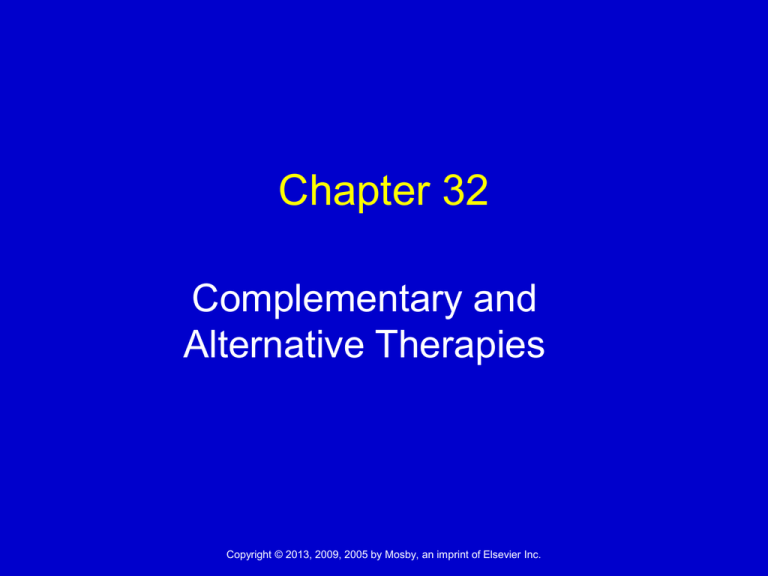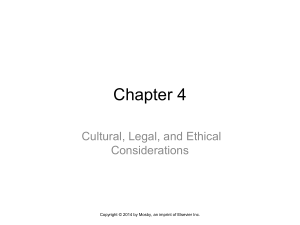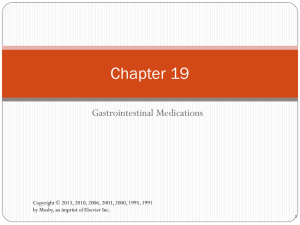Relaxation therapy Meditation and breathing Imagery
advertisement

Chapter 32 Complementary and Alternative Therapies Copyright © 2013, 2009, 2005 by Mosby, an imprint of Elsevier Inc. Background Many conditions are difficult to treat with allopathic medicine. Researchers estimate that up to 75% of patients seek care from their primary physician for stress, pain, and health conditions for which causes are unknown. Surveys estimate that 38.3% to 62.1% of the U.S. population uses complementary and alternative medicine (CAM). Copyright © 2013, 2009, 2005 by Mosby, an imprint of Elsevier Inc. 2 Case Study Joan Brauer is a 46-year-old woman newly diagnosed with hypertension. She works full time, helps care for her widowed mother, and is raising a family of three children with her husband, Tomas. Alonzo is a nursing student assigned to Joan’s care at the clinic. Joan is skeptical about taking antihypertensive medication and asks Alonzo about alternative treatments. Copyright © 2013, 2009, 2005 by Mosby, an imprint of Elsevier Inc. 3 Definitions CAM—a group of diverse medical and health care systems, practices, and products that are not presently considered to be part of conventional medicine. Complementary—therapies used in addition to conventional treatment (aka integrative therapies) Alternative—therapies that replace allopathic medical care Whole medical systems—based on different philosophies and life systems Copyright © 2013, 2009, 2005 by Mosby, an imprint of Elsevier Inc. 4 Categories of CAM Biologically based therapies Energy therapies Manipulative and body-based methods Mind-body interventions Whole medical systems Movement therapies Copyright © 2013, 2009, 2005 by Mosby, an imprint of Elsevier Inc. 5 Integrative Health Care Many medical and nursing schools incorporate CAM therapy content into the curriculum. Some have integrative health care programs that allow health care consumers the opportunity to be treated by a team of providers consisting of both allopathic and complementary practitioners. Nurses have historically practiced in an integrative fashion, using the term holistic. Copyright © 2013, 2009, 2005 by Mosby, an imprint of Elsevier Inc. 6 Holistic Nursing Regards and treats the mind-bodyspirit of the patient Uses holistic nursing interventions such as relaxation therapy, music therapy, touch therapies, and guided imagery The American Holistic Nurses Association maintains Standards of Holistic Nursing Practice. Copyright © 2013, 2009, 2005 by Mosby, an imprint of Elsevier Inc. 7 Factors to Consider The history of each therapy (many have been used by cultures for thousands of years to support health and ameliorate suffering) Nursing’s history and experience with a particular therapy Other forms of evidence reporting outcomes and safety data, including case study and qualitative research Cultural influences and context for certain patient populations Copyright © 2013, 2009, 2005 by Mosby, an imprint of Elsevier Inc. 8 Nursing-Accessible Therapies Relaxation therapy Meditation and breathing Imagery Copyright © 2013, 2009, 2005 by Mosby, an imprint of Elsevier Inc. 9 Relaxation Therapy Definitions: Stress response Relaxation response Progressive relaxation Passive relaxation Clinical applications: lowers heart rate and blood pressure, decreases muscle tension Limitations Copyright © 2013, 2009, 2005 by Mosby, an imprint of Elsevier Inc. 10 Yoga Copyright © 2013, 2009, 2005 by Mosby, an imprint of Elsevier Inc. 11 Meditation and Breathing Meditation is any activity that limits stimulus input by directing attention to a single unchanging or repetitive stimulus, so the person is able to become more aware of self. Lowers oxygen consumption, reduces respiratory and heart rates, and reduces anxiety Lowers blood pressure (BP) in hypertensive patients and lowers breathing rates in asthmatic patients and in cancer patients Copyright © 2013, 2009, 2005 by Mosby, an imprint of Elsevier Inc. 12 Imagery or Visualization A mind-body therapy that uses the conscious mind to create mental images to stimulate physical changes in the body, improve perceived well-being, and/or enhance selfawareness Creative visualization is one form of self-directed imagery based on mind-body connectivity. Clinical applications: pain control ++ Limitations: a few side effects Copyright © 2013, 2009, 2005 by Mosby, an imprint of Elsevier Inc. 13 Case Study (cont’d) Alonzo realizes that to reassure Joan, he needs to assess her needs. Alonzo interviews Joan about her daily life and discovers that she feels stressed at work and at home. Joan says that although her husband helps her with housework, they have not required the children to do so. Joan feels like she’s “on duty” 24-7 because of the shopping, cooking, and housework, in addition to her job. Alonzo and Joan discuss how she could delegate some of her home tasks to her children. Copyright © 2013, 2009, 2005 by Mosby, an imprint of Elsevier Inc. 14 Training-Specific Therapies Biofeedback Acupuncture Therapeutic touch Chiropractic Therapy Traditional Chinese medicine Natural products and herbal therapies Copyright © 2013, 2009, 2005 by Mosby, an imprint of Elsevier Inc. 15 Biofeedback A mind-body technique that uses instruments to teach self-regulation and voluntary selfcontrol over specific physiological responses Instruments measure, process, and provide information about neuromuscular and autonomic nervous system activity. Immediate feedback is provided in physical, physiological, auditory, and/or visual signals. Copyright © 2013, 2009, 2005 by Mosby, an imprint of Elsevier Inc. 16 Acupuncture Regulates or realigns vital energy (qi), which flows through channels in the form of a system of pathways called meridians Involves insertion of needles into acupoints through which qi can be influenced. Modifies the body’s response to pain and how pain is processed by central neural pathways and cerebral function Effective for pain Also used to treat other disorders with varying effectiveness Copyright © 2013, 2009, 2005 by Mosby, an imprint of Elsevier Inc. 17 Acupuncture (cont’d) Copyright © 2013, 2009, 2005 by Mosby, an imprint of Elsevier Inc. 18 Case Study (cont’d) Alonzo emphasizes to Joan that even though CAM methods may help her blood pressure, she needs to take her hypertensive medication as prescribed. Joan agrees to do so as long as Alonzo helps her learn about other possible ways to improve her health. Alonzo gives Joan information about relaxation therapy, imagery, and meditation. They decide to discuss which method Joan would like to try on her next visit. Copyright © 2013, 2009, 2005 by Mosby, an imprint of Elsevier Inc. 19 Therapeutic Touch Practitioner places open palms on or close to the patient’s body. Five phases: centering, assessing, unruffling, treating, and evaluating Practitioner uses long downward strokes to touch or maintain the hands in a position a few inches from the body May be effective in treating pain, dementia, trauma, and anxiety Copyright © 2013, 2009, 2005 by Mosby, an imprint of Elsevier Inc. 20 Therapeutic Touch (cont’d) Copyright © 2013, 2009, 2005 by Mosby, an imprint of Elsevier Inc. 21 Chiropractic Therapy Goal: restore structural and functional imbalances Joint manipulation, physical therapies, lifestyle counseling (diet and exercise) Improves acute pain and disability, enhances conventional treatment of pediatric asthma Contraindicated for bone infections, fractures, dislocations, osteoporosis Some risks, although uncommon, are present. Copyright © 2013, 2009, 2005 by Mosby, an imprint of Elsevier Inc. 22 Traditional Chinese Medicine Whole system of healing Health viewed as “life in balance”; harmony Includes several therapies: herbs, exercise, diet, acupuncture, moxibustion, meditation, ++ Yin and yang are opposing, complementary forces that exist in dynamic equilibrium. Disruption of vital energy (qi) causes disease. Chinese herbs not regulated by the U.S. Food and Drug Administration (FDA). Ask about all parts of TCM therapy; herbs, teas, and supplements may interact with allopathic treatment. Copyright © 2013, 2009, 2005 by Mosby, an imprint of Elsevier Inc. 23 Natural Products and Herbal Therapies A natural product is a chemical compound or substance produced by a living organism. Herbal medicines are not approved for use as drugs and are not regulated by the FDA. Although many herbs are safe and effective for a variety of conditions, “natural” does not equal “safe.” Some interact with prescription and over-the-counter medications. Look for U.S. Pharmacopeia (USP)-verified dietary supplement mark. Copyright © 2013, 2009, 2005 by Mosby, an imprint of Elsevier Inc. 24 Case Study (cont’d) At Joan’s follow-up visit, Joan tells Alonzo she would like to learn the relaxation response. Joan is excited about having control over a behavior that can help her manage her blood pressure, so she eagerly learns. Joan reports that she and Tomas have assigned the children household duties, and so Joan had a free hour the night before— and didn’t know what to do with it! Copyright © 2013, 2009, 2005 by Mosby, an imprint of Elsevier Inc. 25 Quick Quiz! 1. An athletic young woman has just broken her leg while training for a marathon. The use of meditation has many physiological properties that will help the young woman to A. Raise blood pressure. B. Increase mood swings. C. Increase oxygen consumption. D. Lower muscle tension. Copyright © 2013, 2009, 2005 by Mosby, an imprint of Elsevier Inc. 26 Nursing Role in CAM Therapies Need to encourage dialogue about the use of CAM Responsibility to understand the benefits of therapies that encourage active patient participation Multiple practitioner approach: integrative Holistic in nature Follow Nurse Practice Act Scope of Practice. Work closely with patient. Copyright © 2013, 2009, 2005 by Mosby, an imprint of Elsevier Inc. 27




